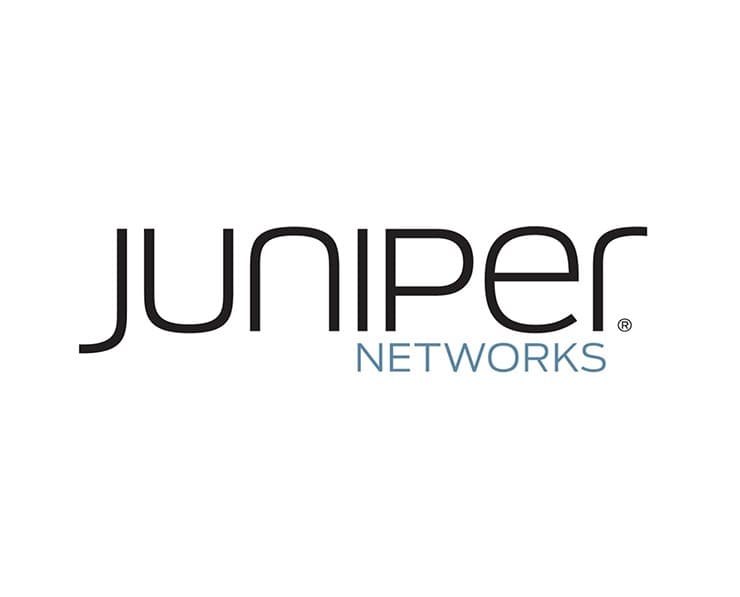Student Feedback
JN0-103: Junos, Associate (JNCIA-Junos) Certification Video Training Course Outline
Networking Fundamentals
Junos Fundamentals
Installing Junos on VirtualBox
User Interfaces
Junos Configuration Basics
Operational Monitoring and Maint...
Routing Fundamentals
Routing Policy and Firewall Filters
Networking Fundamentals
JN0-103: Junos, Associate (JNCIA-Junos) Certification Video Training Course Info
Complete Juniper JN0-103: Junos, Associate (JNCIA-Junos) Training Course
Learn networking fundamentals, Junos OS configuration, routing, monitoring, and firewall policies for JNCIA-Junos certification.
What You Will Learn from This Course
Understanding of networking fundamentals, including IP addressing, subnetting, and routing protocols, which are essential for managing modern networks effectively.
Familiarity with the Junos OS architecture, including the control plane, forwarding plane, and how they interact to ensure network stability and performance.
Proficiency in using Junos OS user interfaces such as the CLI and J-Web, allowing efficient device configuration, monitoring, and troubleshooting.
Ability to configure basic network settings and manage configurations in Junos OS, including interface setup, routing configuration, and system parameters.
Skills to monitor and maintain Junos OS devices effectively, including using diagnostic commands, analyzing logs, and performing routine maintenance.
Knowledge of routing fundamentals and the ability to configure static and dynamic routing protocols which are key for network scalability and reliability.
Understanding of routing policies and firewall filters to control network traffic, enforce security, and optimize network performance.
Competence in understanding the flow of traffic through Junos devices, differentiating between transit and exception traffic, and applying configurations to handle both efficiently.
Ability to apply best practices for network security, including implementing access control lists, monitoring traffic, and protecting network devices from unauthorized access.
Capability to use network tools such as ping, traceroute, SSH, and telnet for troubleshooting connectivity issues and ensuring devices operate correctly.
Learning Objectives
Upon completing this course, you will be able to:
Identify and explain the core components of networking, including routers, switches, collision domains, broadcast domains, and their roles in the network.
Describe the architecture and functionality of the Junos OS, including understanding the responsibilities of the Routing Engine and Packet Forwarding Engine.
Navigate and utilize the Junos OS user interfaces for configuration and monitoring, including the use of CLI commands, navigation modes, and J-Web interface features.
Configure basic network settings and manage configurations in Junos OS, such as setting IP addresses, configuring interfaces, creating VLANs, and managing the configuration hierarchy.
Monitor system performance and troubleshoot common issues in Junos OS using show and monitor commands, analyzing system logs, and applying corrective measures when needed.
Configure and manage static and dynamic routing protocols in Junos OS, including RIP, OSPF, and BGP, and understand the principles of route preference, next-hop selection, and routing tables.
Implement routing policies and firewall filters to control network traffic, define policy rules, manage input and output filters, and secure the network against unauthorized or malicious traffic.
Apply knowledge of packet processing and traffic flow to optimize network performance, including understanding how Junos OS handles normal and exceptional traffic.
Understand the importance of configuration management, including performing backups, rollbacks, and applying changes safely to maintain network stability.
Develop the foundational knowledge required to pursue further Juniper certifications, including JNCIS and JNCIP, which build on the skills learned in this course.
Target Audience
This course is intended for:
Individuals seeking to gain foundational knowledge in networking and Junos OS, including those with limited prior experience in networking technologies.
Network professionals aiming to achieve the JNCIA-Junos certification, which serves as a recognized credential in the IT and networking industry.
IT professionals looking to expand their skills in Junos OS for career advancement, enabling them to work with Juniper devices in enterprise and service provider networks.
Students and recent graduates interested in pursuing a career in network administration are provided with essential knowledge to manage and configure network devices.
Professionals transitioning from other networking platforms who want to learn Junos OS, including network engineers familiar with Cisco IOS, Arista EOS, or other operating systems.
System administrators responsible for managing network infrastructure who require a deeper understanding of routing, switching, and security configurations in Junos OS.
Anyone preparing for technical interviews or job roles that involve Juniper device management, network monitoring, and traffic optimization.
Overview
The JNCIA-Junos certification, identified by exam code JN0-103, is designed to validate an individual's knowledge and skills in networking and the Junos OS. This certification serves as the entry point into Juniper Networks' certification tracks, including Enterprise Routing and Switching and Service Provider Routing and Switching. The certification ensures that network professionals understand the fundamental concepts required to manage Juniper devices effectively.
The course begins by introducing networking concepts such as IP addressing, subnetting, and routing principles, which are crucial for understanding how devices communicate within a network. Students will learn how switches and routers operate, the differences between collision and broadcast domains, and how data flows across network layers. This foundation prepares learners for more advanced topics related to Junos OS.
In the Junos OS fundamentals section, learners explore the architecture of the operating system, including the roles of the Routing Engine and Packet Forwarding Engine. Understanding how these components work together to process and forward traffic is essential for network stability. Students will also learn about exception traffic, commit and rollback operations, and the hierarchical configuration structure of Junos OS.
The course emphasizes practical skills by teaching the use of Junos OS interfaces, including the CLI and J-Web. Learners gain hands-on experience navigating configuration and operational modes, issuing show and monitor commands, and analyzing system logs. These skills are critical for day-to-day network management and troubleshooting.
Basic configuration topics cover interface setup, IP address assignment, VLAN creation, and routing configuration. Students practice applying configuration changes safely, understanding the differences between candidate and active configurations, and using commit and rollback operations to ensure network reliability.
Monitoring and maintenance skills are reinforced through the use of diagnostic commands, performance monitoring, and understanding system logs. Learners are taught to identify potential issues proactively, troubleshoot problems effectively, and apply maintenance procedures to keep Juniper devices running optimally.
Routing fundamentals are covered extensively, including static routing, dynamic routing protocols like RIP, OSPF, and BGP, route preference, and routing tables. Students learn how to influence traffic flow using routing policies, implement firewall filters for security, and ensure that network traffic is handled efficiently.
The course concludes by highlighting the importance of configuration management, network security best practices, and the foundational knowledge required for advanced Juniper certifications. By completing this course, learners acquire the skills needed to configure, manage, monitor, and troubleshoot Junos OS devices, making them prepared for the JN0-103 certification exam and real-world networking scenarios.
Prerequisites
There are no formal prerequisites for this course, making it accessible to individuals with varying levels of networking experience. However, having a basic understanding of networking concepts, such as IP addressing, subnetting, and routing, will be beneficial for grasping more advanced topics. Familiarity with computer operating systems and command-line interfaces can also aid in understanding the course material. Learners should be comfortable working with network devices, interpreting logs, and applying configuration changes. Previous experience with other networking platforms may provide additional context, but it is not required. The course is designed to provide a comprehensive introduction to Junos OS and networking fundamentals, ensuring that all learners gain the necessary knowledge to progress in their networking careers and pursue the JNCIA-Junos certification.
Course Modules / Sections
The JN0-103: Junos, Associate (JNCIA-Junos) training course is organized into comprehensive modules designed to guide learners progressively from foundational networking concepts to advanced Junos OS configuration and operational skills. Each module is structured to provide both theoretical knowledge and hands-on practice to ensure a solid understanding of Junos OS and network management principles.
The first module focuses on networking fundamentals. This module introduces the basic building blocks of networking, including an understanding of network devices such as routers and switches, their roles in a network, and how data flows through different layers of the OSI and TCP/IP models. Topics such as collision domains, broadcast domains, and the differences between Layer 2 and Layer 3 communication are emphasized. Learners also gain insight into Ethernet technologies, media types, and cabling standards, which form the backbone of any network infrastructure. This foundational knowledge ensures that learners can understand how Junos OS interacts with network devices and protocols.
The second module covers Junos OS fundamentals. Here, learners explore the architecture of Junos OS, including the separation of the control plane and forwarding plane, which ensures stability and performance in network operations. The module explains the functions of the Routing Engine (RE) and Packet Forwarding Engine (PFE), emphasizing their roles in routing, packet processing, and exception handling. Learners also gain an understanding of the software hierarchy in Junos OS, including the difference between active and candidate configurations, commit and rollback operations, and system features that enhance reliability and maintainability.
The third module delves into user interfaces and operational navigation within Junos OS. Learners become proficient in using the command-line interface (CLI), understanding operational and configuration modes, and employing helpful CLI commands for real-time system management. The module also introduces J-Web, Junos OS’s graphical user interface, which allows learners to manage devices via a web browser. Through this module, learners gain practical experience in navigating the system, interpreting outputs, and managing devices effectively using different interfaces.
The fourth module focuses on basic configuration skills. This includes configuring interfaces, assigning IP addresses, and setting up VLANs and routing configurations. Learners practice using configuration commands, understanding the hierarchy of the configuration tree, and applying changes safely through the commit process. The module emphasizes hands-on labs that reinforce theoretical knowledge, allowing learners to configure devices and verify their settings using operational commands.
The fifth module addresses operational monitoring and maintenance. Learners explore methods to monitor device performance, analyze system logs, and troubleshoot network issues. The module covers show and monitor commands in detail, explaining how to check interfaces, routing tables, system resources, and traffic statistics. It also teaches maintenance tasks such as system reboot, shutdown procedures, and software upgrades. Emphasis is placed on proactive monitoring to prevent network disruptions and maintain device reliability.
The sixth module covers routing fundamentals. Learners study static routing, dynamic routing protocols such as RIP, OSPF, and BGP, and learn how to configure these protocols within Junos OS. The module explains routing tables, route preference, next-hop selection, and route redistribution. Practical labs allow learners to configure routes, verify network connectivity, and ensure proper traffic flow across devices.
The seventh and final module introduces routing policies and firewall filters. Learners gain knowledge in defining and applying policies to influence routing decisions, manage traffic flow, and enhance network security. The module explains how to implement firewall filters, including input, output, and forwarding filters, to control traffic entering and leaving interfaces. Learners also explore policy evaluation order and filter precedence to ensure network policies are applied correctly.
Key Topics Covered
The course covers a wide range of topics essential for achieving proficiency in Junos OS and for preparing for the JN0-103 exam.
Networking fundamentals include understanding Ethernet networks, collision and broadcast domains, MAC addressing, and the differences between Layer 2 and Layer 3 communication. Learners study IP addressing and subnetting, including both IPv4 and IPv6, as well as supernetting and route summarization. The course also explains the difference between connection-oriented and connectionless protocols, helping learners differentiate between TCP and UDP traffic.
Junos OS fundamentals cover the architecture of the system, including the control and forwarding planes, the Routing Engine, and the Packet Forwarding Engine. Learners study system processes, packet processing paths, and exception handling. Features such as rollback, commit, and configuration hierarchy are explained in detail, highlighting the importance of maintaining network stability.
The user interface section includes an in-depth exploration of CLI commands, configuration and operational modes, and navigation techniques. Learners practice commands such as show version, show interfaces, show configuration, monitor traffic, and monitor system. The use of J-Web for configuration and monitoring is also covered, giving learners alternative ways to manage devices.
Configuration basics include interface setup, IP addressing, VLAN configuration, static routes, and dynamic routing protocol setup. Learners practice applying changes to candidate configurations and committing them to the active configuration. The course emphasizes the importance of safe configuration practices, including the use of rollback to revert changes if necessary.
Operational monitoring and maintenance topics include the use of system logs, performance monitoring tools, troubleshooting procedures, and software upgrades. Learners learn to proactively identify potential issues and apply corrective measures to maintain device stability. Commands for monitoring interfaces, traffic, and system resources are explained in detail.
Routing fundamentals cover static routing, dynamic routing protocols such as RIP, OSPF, and BGP, routing tables, next-hop selection, and route preference. Learners practice configuring routing protocols, verifying connectivity, and troubleshooting routing issues. The course also explores virtual routing and forwarding instances for network segmentation.
Routing policies and firewall filters include defining and applying routing policies, configuring input, output, and forwarding filters, and understanding policy evaluation order. Learners study how to secure networks, control traffic flow, and influence routing decisions. Practical exercises allow learners to implement policies and filters in real-world scenarios.
Teaching Methodology
The course employs a blended teaching methodology that combines theoretical instruction with practical hands-on exercises. Lectures provide conceptual understanding of networking fundamentals, Junos OS architecture, configuration practices, and operational monitoring. Each topic is reinforced with demonstrations and real-world examples that illustrate how Junos OS functions in different network environments.
Hands-on labs are a critical component of the teaching methodology. Learners perform configuration exercises, implement routing protocols, and practice troubleshooting scenarios using either virtual lab environments or physical Juniper devices. These labs allow learners to gain practical experience and reinforce the theoretical knowledge presented during lectures.
The course also encourages interactive learning through scenario-based exercises. Learners are presented with network problems or policy requirements and must apply their knowledge to configure devices, monitor traffic, or implement policies. This approach enhances problem-solving skills and prepares learners for real-world network management.
Supplementary learning materials, such as reference guides, lab manuals, and configuration examples, are provided to support self-paced study. Learners are encouraged to explore Juniper TechLibrary resources and engage with practice exams to assess their understanding of course content.
Regular assessments and feedback sessions are integrated into the teaching methodology. Instructors provide guidance on best practices, highlight common configuration mistakes, and offer corrective feedback on lab exercises. This ensures that learners develop both confidence and competence in using Junos OS.
Assessment & Evaluation
Learners are assessed throughout the course using a combination of practical exercises, lab completion, and theoretical knowledge checks. Each module includes assessments that test the learner’s understanding of key concepts, ability to configure and manage devices, and skill in troubleshooting network issues.
Practical lab assessments require learners to configure interfaces, implement routing protocols, monitor device performance, and apply firewall filters or routing policies. Learners are evaluated on their ability to complete tasks accurately, apply best practices, and troubleshoot any configuration issues that arise.
Theoretical assessments include quizzes and knowledge checks that cover networking fundamentals, Junos OS architecture, command-line usage, configuration principles, routing concepts, and policy implementation. These assessments ensure that learners have internalized the course content and can apply it effectively.
Evaluation is ongoing and includes instructor feedback, peer collaboration, and self-assessment exercises. Learners receive guidance on areas for improvement, tips for exam preparation, and strategies for optimizing network performance in practical scenarios.
Successful completion of the course indicates that learners are well-prepared to attempt the JN0-103 exam, possessing both the theoretical knowledge and practical skills necessary to configure, manage, monitor, and troubleshoot Junos OS devices in real-world network environments.
The combination of structured modules, comprehensive topic coverage, hands-on labs, and continuous assessment ensures that learners develop a strong foundation in Junos OS and networking principles, equipping them with the skills required for professional advancement and certification success.
Benefits of the Course
The JN0-103: Junos, Associate (JNCIA-Junos) training course offers numerous benefits for individuals seeking to enhance their networking knowledge and gain proficiency in Junos OS. One of the primary benefits is the development of a solid foundation in networking concepts, which is crucial for understanding how data flows through networks, how devices communicate, and how protocols interact. This knowledge is not only essential for passing the certification exam but also for managing real-world network environments effectively.
Another benefit is gaining expertise in Junos OS, one of the leading network operating systems used in enterprise and service provider networks. By learning the architecture, user interfaces, and configuration processes of Junos OS, learners are equipped to manage devices efficiently, ensuring network stability and performance. Familiarity with Junos OS also opens doors to advanced certifications and specialized career paths within network administration, network engineering, and cybersecurity.
The course emphasizes practical skills, enabling learners to configure interfaces, assign IP addresses, implement routing protocols, and apply routing policies and firewall filters. This hands-on experience is invaluable for real-world scenarios where network engineers are expected to implement changes, troubleshoot issues, and optimize network performance. Learners also acquire problem-solving skills by working through scenario-based exercises that replicate common network challenges, preparing them for tasks they will encounter in professional environments.
Additionally, learners benefit from understanding network monitoring and maintenance procedures. The course teaches how to use show and monitor commands, analyze system logs, and proactively identify potential network issues. These skills are critical for ensuring uninterrupted network operations and maintaining high availability, which are key responsibilities for any network professional.
The JN0-103 course also provides benefits related to career advancement. The JNCIA-Junos certification is widely recognized in the industry and can enhance employability, increase earning potential, and demonstrate a commitment to professional development. By completing the course, learners signal to employers that they have a validated understanding of networking fundamentals and Junos OS operations, positioning themselves for roles such as network administrator, network engineer, or support specialist.
Furthermore, the course promotes confidence in handling Juniper devices and network configurations. Learners gain the ability to navigate Junos OS interfaces efficiently, implement configurations safely, and apply best practices for network management. This confidence is reinforced through repeated practice and assessment exercises, ensuring that learners are well-prepared for both the certification exam and practical applications in the workplace.
Finally, the course encourages continuous learning and professional growth. By establishing a strong foundation, learners are prepared to pursue advanced Juniper certifications, specialize in routing and switching, or explore areas such as network security and automation. The knowledge and skills acquired through this course provide a stepping stone for long-term career development in the networking industry.
Course Duration
The JN0-103 course is structured to provide comprehensive coverage of all exam objectives and practical skills within a well-paced schedule. Typically, the course spans multiple days or weeks, depending on the training format chosen. For instructor-led training, the course duration is usually around five days, with full-day sessions covering lectures, demonstrations, and hands-on labs. This format allows learners to interact with instructors, ask questions, and receive immediate feedback on their progress.
For self-paced or online learning formats, the course may extend over several weeks, allowing learners to progress at their own pace. Self-paced learners can revisit modules, practice lab exercises multiple times, and review key concepts as needed. The total estimated study time for self-paced learners is typically 30 to 40 hours, including time spent on reading materials, completing exercises, and practicing with virtual lab environments.
The course schedule is designed to balance theoretical instruction with practical application. Each module builds on the previous one, ensuring that learners develop a deep understanding of networking principles before applying them in Junos OS configurations. Practical lab sessions are interspersed with lectures to reinforce learning and allow learners to immediately implement the concepts being taught.
Learners are encouraged to dedicate additional time outside structured course hours to practice and review. This includes setting up lab environments, experimenting with configurations, and simulating real-world network scenarios. Regular practice enhances retention, improves problem-solving skills, and prepares learners for the hands-on nature of the JN0-103 exam.
The duration of the course also accounts for assessment and evaluation. Learners engage in knowledge checks, quizzes, and lab exercises throughout the course to monitor their understanding. These assessments ensure that learners are grasping key concepts and developing the practical skills required to succeed in network management and the certification exam.
In summary, the course duration is designed to provide a comprehensive learning experience that balances instruction, practice, and evaluation. Whether learners choose an instructor-led, classroom-based format or a self-paced online option, the schedule allows sufficient time to master networking fundamentals, Junos OS concepts, and hands-on configuration and monitoring skills.
Tools & Resources Required
To fully benefit from the JN0-103 course, learners require access to a combination of hardware, software, and reference resources. One of the primary tools needed is access to Juniper network devices or virtual labs that emulate Junos OS environments. Juniper vLabs or equivalent virtual platforms provide a cost-effective way for learners to practice configuration, routing, and troubleshooting exercises without the need for physical hardware. These virtual labs simulate real-world scenarios and allow learners to explore features, commands, and configurations safely.
Learners also need a reliable computer or workstation capable of running virtual lab software, accessing course materials, and connecting to virtual networks. A stable internet connection is essential for online learning, accessing documentation, and participating in interactive exercises or instructor-led sessions. For classroom-based training, computers may be provided, but self-paced learners should ensure their setup meets the technical requirements for running lab environments.
Reference materials are another critical resource. Learners should have access to Juniper documentation, including TechLibrary guides, configuration manuals, and command references. These resources provide detailed explanations of Junos OS features, commands, and configuration examples, serving as a supplement to course lectures and lab exercises.
Software tools for network testing and diagnostics, such as ping, traceroute, SSH clients, and telnet, are required to perform troubleshooting exercises effectively. These tools allow learners to verify connectivity, test configurations, and analyze network behavior, reinforcing theoretical knowledge with practical application.
Additionally, learners benefit from study guides, practice exams, and lab manuals that provide structured exercises and simulated exam questions. These resources help learners assess their readiness for the JN0-103 exam, identify areas for improvement, and build confidence in their understanding of networking concepts and Junos OS operations.
Collaboration tools, such as discussion forums, virtual classrooms, and chat platforms, can enhance the learning experience by allowing learners to interact with instructors and peers. These tools facilitate the exchange of ideas, troubleshooting tips, and best practices, creating a supportive learning environment.
Finally, learners should have access to note-taking tools or digital notebooks to record commands, configurations, and important concepts during the course. Maintaining a personal reference repository allows learners to review key topics quickly, practice configurations, and reinforce their understanding of Junos OS and networking principles.
In conclusion, the JN0-103 course provides a structured learning environment supported by essential tools and resources. Access to virtual labs, reference documentation, diagnostic software, and collaborative platforms ensures that learners can gain hands-on experience, reinforce theoretical knowledge, and prepare effectively for the JNCIA-Junos certification exam and real-world network management scenarios.
Career Opportunities
Completing the JN0-103: Junos, Associate (JNCIA-Junos) training course opens a wide range of career opportunities in the networking and IT industry. One of the most immediate benefits is qualifying for roles that require foundational knowledge of networking concepts and Junos OS management. Positions such as network administrator, network support engineer, and junior network engineer become accessible to individuals who have completed the course and obtained the JNCIA-Junos certification. These roles often involve configuring, monitoring, and maintaining network devices, ensuring the smooth operation of enterprise and service provider networks.
The certification also enhances employability for network operations center (NOC) technician positions. Professionals in these roles are responsible for monitoring network performance, responding to alerts, troubleshooting connectivity issues, and escalating complex problems to senior engineers. With a strong understanding of Junos OS, candidates can efficiently manage Juniper devices, perform routine maintenance, and contribute to the overall reliability of the network infrastructure.
Service provider networks, including telecommunications companies and internet service providers, offer additional career opportunities. Roles such as service provider network engineer or routing and switching engineer require knowledge of Junos OS for configuring core network devices, implementing routing protocols, and optimizing traffic flow. Professionals in these positions apply routing policies, manage firewall filters, and troubleshoot network issues on high-capacity networks, making the JN0-103 certification particularly valuable.
In enterprise environments, the certification prepares candidates for positions in IT departments responsible for network infrastructure management. Roles such as IT network administrator, system network engineer, or network operations engineer involve deploying and managing routers, switches, and security devices. Professionals are expected to maintain connectivity, implement security policies, and ensure network performance, all of which are skills developed through the JN0-103 training course.
For individuals interested in career growth and specialization, the JNCIA-Junos certification serves as a stepping stone to advanced Juniper certifications such as JNCIS (Juniper Networks Certified Specialist) and JNCIP (Juniper Networks Certified Professional). These advanced certifications open doors to senior network engineer, network architect, and network security specialist roles. By establishing a solid foundation through JN0-103, professionals are well-prepared to pursue these higher-level certifications and advance their careers.
The course also benefits those interested in consulting or freelance networking work. Knowledge of Junos OS allows professionals to provide network design, configuration, and troubleshooting services to multiple clients. This flexibility is valuable for independent consultants who need to manage a variety of network environments and deliver solutions efficiently.
Network automation and cloud integration are emerging areas in the IT industry where Junos OS expertise is increasingly relevant. Professionals who understand Junos OS, routing protocols, and configuration management can contribute to network automation projects, implement programmable network devices, and integrate Juniper networks with cloud platforms. The skills gained through the JN0-103 course provide a strong foundation for these modern networking roles, making learners competitive in a rapidly evolving industry.
In addition to technical roles, the certification can enhance career prospects in IT management and network project coordination. Professionals with a solid understanding of network infrastructure and Junos OS operations can supervise network projects, manage implementation teams, and ensure that enterprise networks meet performance, security, and reliability standards.
Overall, the JN0-103 course equips learners with a versatile skill set applicable across various industries and roles. From entry-level positions to advanced career paths in networking, the knowledge and skills gained through this course provide a strong foundation for professional growth, enhanced employability, and long-term career advancement in the IT and networking fields.
Conclusion
The JN0-103: Junos, Associate (JNCIA-Junos) training course provides a comprehensive introduction to networking concepts, Junos OS architecture, configuration, monitoring, and operational management. By covering networking fundamentals, interface configuration, routing protocols, policy implementation, and firewall filtering, the course ensures that learners acquire both theoretical knowledge and practical skills required to manage Juniper networks effectively. The training emphasizes hands-on labs, scenario-based exercises, and real-world examples, preparing learners for the JNCIA-Junos certification exam and professional networking responsibilities.
The course is designed for a wide range of learners, from students and recent graduates to IT professionals seeking career advancement. No formal prerequisites are required, although basic networking knowledge and familiarity with command-line interfaces can enhance the learning experience. By combining lectures, demonstrations, lab exercises, and assessments, the course ensures that learners develop a thorough understanding of Junos OS operations and network management principles.
The structured modules of the course cover networking fundamentals, Junos OS architecture, user interfaces, configuration, operational monitoring, routing, and policy management. Each module builds on the previous one, allowing learners to progress systematically while reinforcing critical concepts through practice and application. Tools and resources such as virtual labs, reference manuals, diagnostic software, and collaboration platforms support hands-on learning and self-paced study.
Completing the course and earning the JNCIA-Junos certification provides tangible benefits, including enhanced technical skills, increased employability, and access to a wide range of career opportunities. Professionals can pursue roles such as network administrator, network engineer, NOC technician, service provider network engineer, and IT network operations specialist. The certification also serves as a foundation for advanced Juniper certifications, enabling career growth into senior and specialized network roles.
The JN0-103 training course emphasizes practical experience and real-world applicability. Learners gain the ability to configure and manage network devices, implement routing protocols, monitor performance, apply routing policies and firewall filters, and troubleshoot common network issues. This practical focus ensures that learners are not only prepared for the certification exam but also equipped to contribute effectively in professional network environments.
Furthermore, the course promotes long-term professional development. By mastering Junos OS fundamentals and networking principles, learners can explore advanced topics such as network automation, cloud integration, and security management. The skills acquired through this course provide a strong foundation for continuous learning, specialization, and career advancement in the networking and IT industry.
The structured, hands-on approach, combined with comprehensive coverage of exam objectives, makes the JN0-103 training course an essential step for anyone pursuing a career in networking or seeking to validate their expertise in Junos OS. By completing this course, learners gain the confidence, skills, and credentials necessary to manage network devices effectively, optimize performance, secure networks, and pursue further professional growth.
Enroll Today
Enrolling in the JN0-103: Junos, Associate (JNCIA-Junos) training course is the first and most important step toward achieving professional recognition and career advancement in the networking industry. This course is meticulously designed to provide a structured learning path that covers all critical aspects of Junos OS and foundational networking concepts, ensuring learners are fully prepared to meet the demands of the JNCIA-Junos certification exam. By enrolling, learners gain access to a comprehensive curriculum that includes theoretical instruction, practical demonstrations, and hands-on lab exercises. These components work together to build a deep understanding of networking principles and the operational capabilities of Juniper devices, ensuring that students acquire not just knowledge but also practical expertise that can be applied directly in real-world network environments.
Joining this course also offers access to expert instructors who bring years of industry experience and technical insight to the learning process. These instructors guide learners through complex concepts, provide demonstrations of real-world network configurations, and share best practices that help learners develop a professional approach to network management. The course emphasizes active learning, encouraging participants to practice configurations, troubleshoot network issues, and monitor device performance using Junos OS tools. This hands-on approach ensures that learners are not only theoretically prepared but also practically competent, giving them confidence in managing network devices effectively.
One of the key advantages of enrolling in this course is access to essential tools and resources that enhance the learning experience. These include virtual lab environments, configuration guides, practice exercises, diagnostic tools, and interactive learning materials. Virtual labs allow learners to simulate real-world network scenarios, experiment with configurations, and observe the impact of routing policies, firewall filters, and routing protocols in a controlled environment. Reference materials and study guides provide structured content to reinforce learning, while diagnostic tools enable learners to monitor network performance, troubleshoot issues, and apply corrective measures efficiently. This combination of resources ensures a rich, immersive learning experience that prepares learners for both the certification exam and professional network management responsibilities.
Taking this course equips learners with the critical skills needed to configure, monitor, and maintain Juniper network devices effectively. Participants gain proficiency in setting up interfaces, assigning IP addresses, configuring VLANs, implementing static and dynamic routing, and applying routing policies and firewall filters to control traffic flow. Additionally, learners develop the ability to use monitoring commands, analyze system logs, troubleshoot common network problems, and ensure the stability and reliability of network infrastructure. These skills are essential for managing enterprise networks, service provider networks, and IT environments where Junos OS devices are deployed, making learners valuable assets to any organization.
Beyond the immediate technical benefits, this course lays a solid foundation for further specialization and advanced certifications. Completing the JN0-103 course enables learners to pursue higher-level Juniper certifications such as JNCIS and JNCIP, which open doors to senior network engineering roles, network architecture positions, and specialized security or automation-focused careers. The knowledge and skills gained in this course provide a stepping stone for continued professional growth, ensuring that learners can expand their expertise and stay competitive in a rapidly evolving networking industry.
Enrolling in the JN0-103 course also provides long-term career advantages. Certified professionals often enjoy higher employability, enhanced credibility, and greater opportunities for career advancement. The certification demonstrates to employers and peers that the learner possesses verified knowledge of networking fundamentals, Junos OS configuration, and network management practices. This recognition can lead to roles in enterprise networks, service providers, network operations centers, IT management, and network consulting. It also provides the confidence and skillset required to take on challenging projects, implement secure and efficient network designs, and contribute strategically to organizational objectives.













